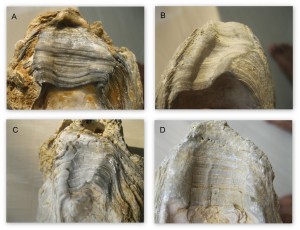Dinosaurs might have survived the asteroid strike that wiped them out if it had taken place slightly earlier or later in history, scientists say. A fresh study using up-to-date fossil records and improved analytical tools has helped palaeontologists to build a new narrative of the prehistoric creatures’ demise, some 66 million years ago. They found […]
Archive for July, 2014
Leaf-mining insects destroyed with the dinosaurs, others quickly appeared
 July 27th, 2014
July 27th, 2014  Riffin
Riffin After the asteroid impact at the end of the Cretaceous period that triggered the dinosaurs’ extinction and ushered in the Paleocene, leaf-mining insects in the western United States completely disappeared. Only a million years later, at Mexican Hat, in southeastern Montana, fossil leaves show diverse leaf-mining traces from new insects that were not present during […]

PRESENCE OF MIOCENE OYSTERS: RISE AND FALL OF A PALEO-ESTUARY IN THE EAST COAST OF INDIA
 July 26th, 2014
July 26th, 2014  Riffin
Riffin Living oysters of Crassostrea Sp. are abundantly found on the east coast of peninsular India. Most of the living Crassostrea sp. is reported from Athankarai estuary near mandapam. The primary object of this study is to report the occurrence of fossils of Crassostrea sp. belonging to mio-pliocene outcrops from an ephemeral stream channel of Nambiyar/Thoppuvila […]
The bend in the Appalachian mountain chain is finally explained
 July 24th, 2014
July 24th, 2014  Riffin
Riffin The 1500 mile Appalachian mountain chain runs along a nearly straight line from Alabama to Newfoundland — except for a curious bend in Pennsylvania and New York State. Researchers from the College of New Jersey and the University of Rochester now know what caused that bend — a dense, underground block of rigid, volcanic rock […]
Jeju Island, Korea is a live volcano
 July 23rd, 2014
July 23rd, 2014  Riffin
Riffin In Jeju, Korea, a place emerging as a world-famous vacation spot with natural tourism resources, a recent study revealed a volcanic eruption occurred on the island. The Korea Institute of Geoscience and Mineral Resources (KIGAM) indicated that there are the traces that indicated that a recent volcanic eruption was evident 5,000 years ago. This is […]
Fossil of predators brain discovered
 July 22nd, 2014
July 22nd, 2014  Riffin
Riffin An international team of paleontologists has identified the exquisitely preserved brain in the fossil of one of the world’s first known predators that lived in the Lower Cambrian, about 520 million years ago. The discovery revealed a brain that is surprisingly simple and less complex than those known from fossils of some of the animal’s […]
Evidence of super-fast deep earthquake
 July 20th, 2014
July 20th, 2014  Riffin
Riffin As scientists learn more about earthquakes that rupture at fault zones near the planet’s surface — and the mechanisms that trigger them — an even more intriguing earthquake mystery lies deeper in the planet. Scientists at Scripps Institution of Oceanography at UC San Diego have discovered the first evidence that deep earthquakes, those breaking at […]
Changyuraptor yangi sheds light on dinosaur flight
 July 17th, 2014
July 17th, 2014  Riffin
Riffin A new raptorial dinosaur fossil with exceptionally long feathers has provided exciting insights into dinosaur flight. A paper published in Nature Communications on July 15, 2014 asserts that the fossil — discovered by an international team led by Natural History Museum of Los Angeles County (NHM) paleontologist Dr. Luis Chiappe — has a long feathered […]
Gomphothere mandible uncovered
 July 15th, 2014
July 15th, 2014  Riffin
Riffin An animal once believed to have disappeared from North America before humans ever arrived there might actually have roamed the continent longer than previously thought — and it was likely on the list of prey for some of continent’s earliest humans, researchers from the University of Arizona and elsewhere have found. Archaeologists have discovered artifacts […]
First Record of Eocene Bony Fishes and Crocodyliforms from Canada’s Western Arctic
 July 14th, 2014
July 14th, 2014  Riffin
Riffin Discovery of Eocene non-marine vertebrates, including crocodylians, turtles, bony fishes, and mammals in Canada’s High Arctic was a critical paleontological contribution of the last century because it indicated that this region of the Arctic had been mild, temperate, and ice-free during the early – middle Eocene (~53–50 Ma), despite being well above the Arctic Circle. […]



 Posted in
Posted in  Tags:
Tags: 
